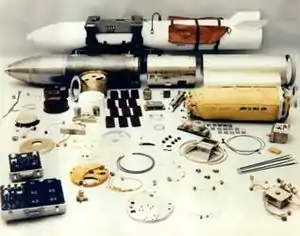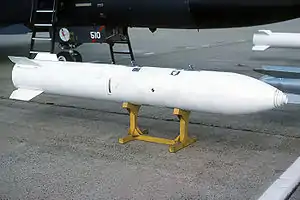B83 nuclear bomb
The B83 is a variable-yield thermonuclear gravity bomb developed by the United States in the late 1970s, and entering service in 1983. With a maximum yield of 1.2 megatons (5.0 PJ), it is the most powerful nuclear weapon in the United States nuclear arsenal.[1] It was designed by Lawrence Livermore National Laboratory.[2]
| B83 | |
|---|---|
 | |
| Type | Unguided bomb |
| Service history | |
| In service | 1983–present |
| Used by | United States |
| Production history | |
| Designer | Lawrence Livermore National Laboratory |
| No. built | 650 |
| Specifications | |
| Mass | 1,100 kilograms (2,400 lb) |
| Length | 3.7 meters (12 ft) |
| Diameter | 46 centimeters (18 in) |
| Blast yield | 1.2 megatons (maximum) |

History
The B83 was based partly on the earlier B77 program, which was terminated because of cost overruns. The B77 was designed with an active altitude control and lifting parachute system for supersonic low-altitude delivery from the B-1A bomber. B77 nuclear component test firings were attributed to the Operation Anvil series in 1975 and 1976, specifically the "Cheese" test shots in Anvil:[2]
- Anvil Kasseri – 28 October 1975, 1,200 kilotonnes of TNT (5,000 TJ) (B77/B83 full yield)
- Anvil Muenster – 3 January 1976, 800 kilotonnes of TNT (3,300 TJ)
- Anvil Fontina – 12 February 1976, 900 kilotonnes of TNT (3,800 TJ)
- Anvil Colby – 14 May 1976, 800 kilotonnes of TNT (3,300 TJ)[2]
The B83 nuclear components have been attributed as the same as the earlier B77.
The B83 replaced several earlier weapons, including the B28, B43, and to some extent the ultra-high-yield B53. It was the first U.S. nuclear weapon designed from the start to avoid accidental detonation, with the use of "insensitive explosives" in the trigger lens system. Its layout is similar to that of the smaller B61, with the warhead mounted in the forward part of the weapon to make the bomb nose-heavy. It was intended for high-speed carriage (up to Mach 2.0) and delivery at high or low altitude. For the latter role, it is equipped with a parachute retardation system, with a 14-meter (46 ft) Kevlar ribbon parachute capable of rapid deceleration. It can be employed in free-fall, retarded, contact, and laydown modes, for air-burst or ground-burst detonation. Security features include next-generation permissive action link (PAL) and a command disablement system (CDS), rendering the weapon tactically useless without a nuclear yield.[2]
The B83 was test fired in the Grenadier Tierra nuclear weapon test on 15 December 1984, at a reduced yield of 80 kilotonnes due to the Threshold Test Ban Treaty.[2]
With the dismantling of the last B53 bomb in 2011, the B83 became the highest yield nuclear weapon in the U.S. arsenal.[3]
Design
The bomb is 3.7 meters (12 ft) long, with a diameter of 460 millimeters (18 in). The actual nuclear explosive package, judging from published drawings, occupies some 0.91 to 1.22 m (3 to 4 ft) in the forward part of the bomb case. The bomb weighs approximately 1,100 kilograms (2,400 lb). The location of the lifting lugs shows that the greater part of the total mass is contained in the nuclear explosive. It has a variable yield: the destructive power is adjustable from somewhere in the low kiloton range up to a maximum of 1.2 megatons (1.2 million tons of TNT). The weapon is protected by a Category "D" Permissive Action Link (PAL) that prevents the enabling or detonation of the weapon without proper authorization.[4][5]
About 650 B83s were built, and the weapon remains in service as part of the United States "Enduring Stockpile".[2]
Aircraft capable of carrying the B83
The following aircraft are capable of launching an attack using the B83 bomb:
- B-1B Lancer (formerly)
- B-2 Spirit
- B-52 Stratofortress[6]
- FB-111
- F-15E Strike Eagle
- F-16 Fighting Falcon
- F/A-18 Hornet
- AV-8B Harrier II
- F-22 Raptor
Nuclear capability has been removed from the B-1B,[7] although it was tested with the B61 nuclear bomb in the mid-1980s, as well as with the ACM, Advanced Cruise Missile (now being retired).
Novel uses
The B83 is one of the weapons considered for use in the "Nuclear Bunker Buster" project, which for a time was known as the Robust Nuclear Earth Penetrator, or RNEP. While most efforts have focused on the smaller B61-11 nuclear bomb, Los Alamos National Laboratory was also analyzing the use of the B83 in this role.
The physics package contained within the B83 has been studied for use in asteroid impact avoidance strategies against any seriously threatening near earth asteroids. Six such warheads, configured for the maximum 1.2 Mt yield, would be deployed by maneuvering space vehicles to "knock" an asteroid off course, should it pose a risk to the Earth.[8]
See also
References
- Blaney, Betsy (26 October 2011). "End of an Era: Last of Big Atomic Bombs dismantled". San Francisco Chronicle. Archived from the original on 28 October 2011. Retrieved 27 October 2011.
- Sublette, Carey. "Nuclear Weapons Archive - B83". Archived from the original on 4 February 2006. Retrieved 23 December 2013.
- Biggest US nuclear bomb dismantled in Texas Archived 18 November 2018 at the Wayback Machine. The Guardian. 25 October 2011.
- Development, United States Congress House Committee on Appropriations Subcommittee on Energy and Water. Energy and Water Development Appropriations for ...: Hearings Before a Subcommittee of the Committee on Approporations, House of Representatives, ... Congress, ... Session. U.S. Government Printing Office.
- President, United States. Fiscal Year ... Arms Control Impact Statements: Statements Submitted to the Congress by the President Pursuant to Section 36 of the Arms Control and Disarmament Act. U.S. Government Printing Office.
- T.O. 1B-52H-1
- Pawlyk, Oriana. "START Lanced the B-1's Nukes, But the Bomber Will Still Get New Bombs". Military.com. Military Advantage. Archived from the original on 26 September 2017. Retrieved 25 September 2017.
- "NASA plans 'Armageddon' spacecraft to blast asteroid" Archived 5 September 2011 at the Wayback Machine article at Flightglobal.com
External links
| Wikimedia Commons has media related to B83 nuclear bomb. |